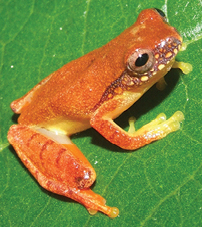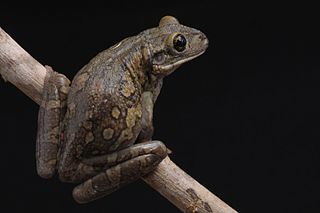Bokermannohyla caramaschii is a species of frogs in the family Hylidae.
Bokermannohyla carvalhoi is a species of frog in the family Hylidae. It is endemic to Brazil. Its natural habitats are subtropical or tropical moist montane forests and rivers. It is threatened by habitat loss, due to deforestation.

Bokermannohyla circumdata is a species of frog in the family Hylidae. It is endemic to Brazil. Its natural habitats are subtropical or tropical moist lowland forests, subtropical or tropical moist montane forests, and rivers. It is threatened by habitat loss.
Bokermannohyla claresignata is a species of frog in the family Hylidae. It is endemic to Serra do Mar, Brazil. Its natural habitats are subtropical or tropical moist lowland forests, subtropical or tropical moist montane forests, and rivers. It is threatened by habitat loss but is protected by Parque da Serra dos Orgãos, and Parque Nacional da Serra Bocaina.
Bokermannohyla gouveai is a species of frog in the family Hylidae. It is endemic to Itatiaia National Park, Brazil. Its natural habitats are subtropical or tropical moist montane forests, subtropical or tropical high-altitude shrubland, rivers, and pastureland. It is threatened by habitat loss for logging and agriculture.

Bokermannohyla hylax is a species of frog in the family Hylidae. It is endemic to Brazil. Its natural habitats are subtropical or tropical moist lowland forests and rivers. It is threatened by habitat loss.
Bokermannohyla ibitipoca is a species of frog in the family Hylidae. It is endemic to Parque Estadual do Ibitipoca, Brazil. Its natural habitats are subtropical or tropical moist montane forests and rivers. It is threatened by habitat degradation for touristic activities.
Bokermannohyla langei is a species of frog in the family Hylidae. It is endemic to Brazil, known only from Paraná. It is known from three specimens collected in 1953 and searches since 1986 have not found this frog. Its natural habitats are subtropical or tropical moist lowland forests, rivers, freshwater marshes, and intermittent freshwater marshes. It may be threatened by touristic activities but is protected by Parque Estadual Pico do Marumbi.

Bokermannohyla lucianae is a species of frogs in the family Hylidae.

Bokermannohyla luctuosa is a species of frog in the family Hylidae. It is endemic to Brazil. Its natural habitats are subtropical or tropical moist lowland forests and rivers. It is threatened by habitat loss.
Bokermannohyla ravida is a species of frogs in the family Hylidae.

Bokermannohyla saxicola is a species of frog in the family Hylidae. It is endemic to Brazil. Its natural habitats are moist savanna, subtropical or tropical moist shrubland, subtropical or tropical high-altitude shrubland, subtropical or tropical dry lowland grassland, rivers, and intermittent rivers. It is threatened by habitat loss.
Bokermannohyla sazimai is a species of frog in the family Hylidae. It is endemic to Serra da Canastra National Park and Uberlândia, Brazil. Its natural habitats are subtropical or tropical dry forests, moist savanna, subtropical or tropical moist shrubland, subtropical or tropical high-altitude shrubland, and rivers. It is threatened by habitat loss for agriculture, logging, fires and construction of dams.

Dendropsophus bipunctatus is a species of frog in the family Hylidae. It is endemic to Brazil. Its natural habitats are subtropical or tropical moist lowland forests, subtropical or tropical moist montane forests, subtropical or tropical moist shrubland, subtropical or tropical seasonally wet or flooded lowland grassland, freshwater marshes, intermittent freshwater marshes, pastureland, and ponds.

Dendropsophus microps, the Nova Friburgo tree frog, is a species of frog in the family Hylidae. It is believed to be endemic to the Atlantic Forest of southern Brazil, but may occur in Argentina as well.

Hallowell's tree frog is a species of frog in the family Hylidae.

Ololygon argyreornatus, commonly known as the Rio Mutum snouted treefrog, is a species of frog in the family Hylidae endemic to Brazil. Its natural habitats are subtropical or tropical moist lowland forests, subtropical or tropical moist montane forests, subtropical or tropical moist shrubland, freshwater marshes, intermittent freshwater marshes, and heavily degraded former forests. It is threatened by habitat loss.

Scinax eurydice is a species of frog in the family Hylidae. It is endemic to Brazil. Its natural habitats are subtropical or tropical moist lowland forests, subtropical or tropical moist shrubland, subtropical or tropical seasonally wet or flooded lowland grassland, swamps, freshwater lakes, intermittent freshwater lakes, freshwater marshes, intermittent freshwater marshes, heavily degraded former forest, and ponds. It is threatened by habitat loss.
Ololygon luizotavioi is a species of frog in the family Hylidae. It is endemic to Brazil.

The black-spotted casque-headed tree frog is a species of frog in the family Hylidae endemic to Brazil. Its natural habitats are subtropical or tropical moist lowland forests, subtropical or tropical moist shrubland, freshwater lakes, intermittent freshwater lakes, freshwater marshes, intermittent freshwater marshes, rural gardens, and heavily degraded former forests. It is threatened by habitat loss.












